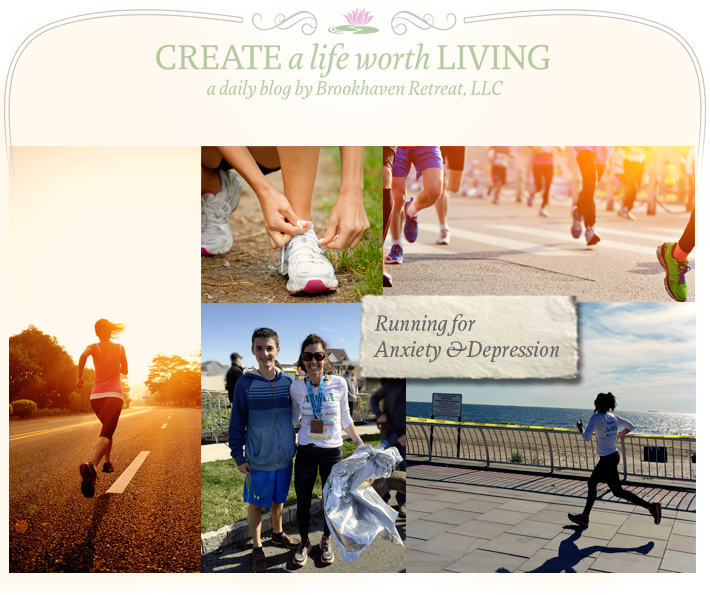
Death is often more difficult for the living, and especially horrific when suicide is the cause. Whenever I come across someone who approaches bereavement with any amount of optimism, I have to step back and take notice.
My daughter recently performed in the school talent show. I overheard Marnie McClure Doherty, the show’s director and a parent who happens to be an overall beautiful human being, telling another parent about the run she was planning to do on April 26. At the time, it was about two weeks away. She was concerned about how well she would do.
To look at her, you’d never imagine she’d have trouble doing anything at all. But as I flexed my eavesdropping muscles, I could tell the run had a higher purpose than a typical race. Then someone else started talking and she mentioned something about her brother dying, and I was crossing the street, so I missed the rest of her story.
On Facebook, I saw Marnie’s post about the race the day before she would run. On a site called Crowdrise.com, whose clever tagline is “If you don’t give back no one will like you,” she created a fundraiser, “Running for ADAA.”
The Anxiety and Depression Association of America (ADAA) is a 35-year-old nonprofit organization that began as a meeting of a small group of people in 1980, who founded the Phobia Society of America in White Plains, NY. The term “anxiety disorder” was instead referred to as phobias. In 2012, the organization became the ADAA because depression and anxiety go together like peanut butter and jelly for a lot of people.
Here is her brief story on Crowdrise:
Dear Friends and Family,
On February 5th, I lost my brother and only sibling, Jim McClure, to anxiety, depression and ultimately the taking of his own life. He was just 43 years old. I am thankful for all the wonderful childhood memories he gave me. His wife and our family are missing him terribly!
Anxiety disorders are the most common mental illness in the U.S., affecting 40 million adults in the United States age 18 and older (18% of U.S. population).
I am running my first half marathon in Long Branch, New Jersey on April 26th in Jim's memory and I am striving to make a significant contribution to the Anxiety and Depression Association of America. While I pray that Jim is now at peace, I am hopeful that more research will improve the lives of the millions afflicted with this painful condition. Thank you for reading and thanks in advance for donating!!
Three days after her run, another friend commented on Marnie’s post, “Congrats on your AMAZING run!! For those that don't know, Marnie McClure Doherty finished in the top 4% in her age group (11th out of 281)! More importantly, she raised over $10,000 for ADAA in memory of her brother Jim! Impressive and inspirational.”
Wow, I thought, she’s in her late 40s like me, and she ran 13 miles faster than most of the people who ran with her. “I started running a few months before my wedding 20 years ago as a way to keep weight off,” she says. “I was a soccer player in middle school through college, so in my mind, long-distance running was boring and arduous, but it worked! I ran a few races over the years, but never longer than a 10k. The half marathon is twice that distance!
“I was very nervous about completing the race because during my long training runs, I would get cramps in my calves around 10 or 11 miles every time. I was dehydrated! When I felt the pain during the race, I drank Gatorade from one of the many volunteers, and all was remedied.”
But being hydrated also meant more tears.
“I thought of Jim many times during the race,” she says. “When I first took off I was happy I was wearing sunglasses because I was instantly emotional, which took me by surprise. The combination of finally being there and all my nerves about finishing and dedicating this big event to him really got me.
“Physically, I felt great and was very quickly relaxed and totally in sync with the pacer I started with. People who volunteer to run races holding signs with times on them to help other runners are saints! I was able to finish under the pacer time by 30 seconds---much faster than I had run during any of my training.”
Marnie’s running tip of the month: Train in very steep terrain and then run a flat race.
As for her brother, Jim, who also made her chuckle at the thought of how much he hated exercise and was probably wondering why she would suffer through such a long run, he had anxiety as early as preschool.
“My mom had to literally peel him off of her leg each morning she dropped him off at school,” she says. “His fear of failure was so intense throughout his life that the thought of completing any large task was often too much for him. He would quit most things that required any kind of stamina in order to not feel the embarrassment of failure. It was hard to watch because he was very smart and gifted with incredible mechanical skills.”
At 13 or 14, he began self-medicating and struggled with alcoholism until his early 30s, when he met his future wife. It is alarming to hear that he got sober, his addiction was replaced with prescription drugs, and yet, Marnie says, "His anxiety coupled with depression continued to cripple him."
The worst part is that he left no clues about what moved him to give up. “It's impossible to know what he was going through at the very end because he didn't leave us a note. All we can hope is that he's finally at peace and not having to endure the incredible burden of his demons any longer.”
Marnie added, “The reason I chose the Anxiety and Depression Association as the beneficiary of my half marathon fundraising is that I wanted to contribute to helping those afflicted with all that pain to find happiness and fulfillment in all the beauty that life has to offer.”
























































